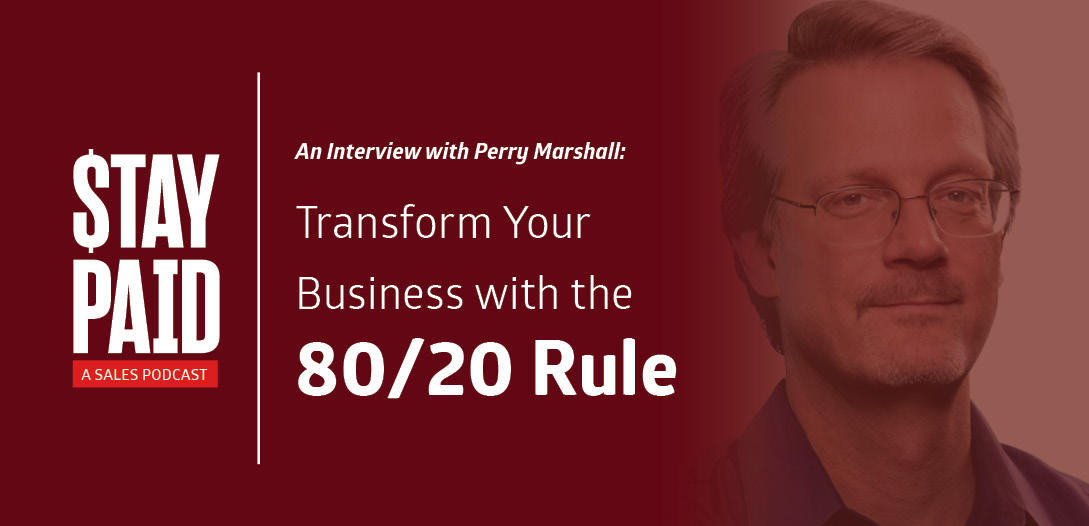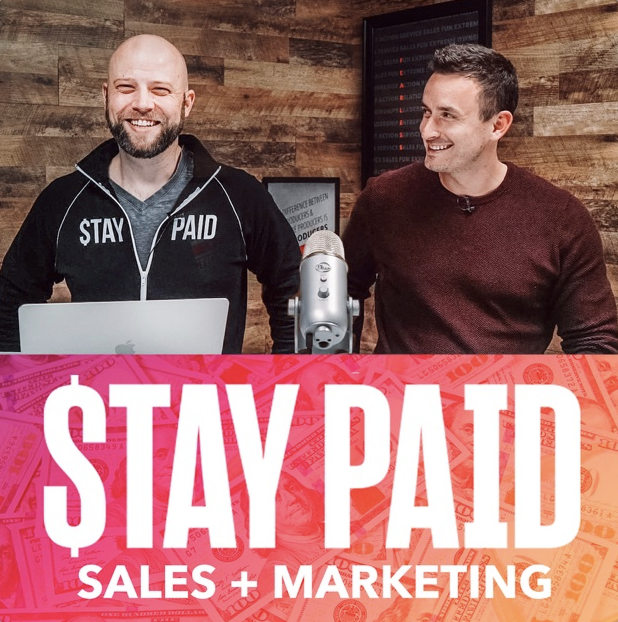Perry Marshall is a world-renowned business consultant and author of Ultimate Guide to Google AdWords—the top selling book, worldwide, on internet advertising. More recently, he reinvented how the 80/20 principle is used in the business world.
Today on Stay Paid, Perry discusses how you can use the 80/20 rule to maximize your profits and eliminate waste.
Key Points:
- In any business, there is a top 20% of profitability or productivity, as well as a top 20% of loss or waste.
- The 80/20 rule is an expanding pattern—meaning 1% of your top customers will give you 50% of your business.
- Identify your biggest assets and invest in those, while eliminating what doesn’t work.
Q: Introduce yourself to our audience.
People know me as the guy who wrote the book on Google advertising. That goes back to when I was an acoustical engineer and got laid off. My wife was 3 months pregnant with our first child. I could not find a suitable job without moving away, so I ended up having to go into sales. I spent two years eating cheap food like ramen or baked potatoes and salsa. I was thrown into the lake and had to swim—and I didn’t swim very well.
After two years, I got fired from my sales job. I took a job at this new company, and, man, I was really lucky. This was the week before Thanksgiving. I did the interview, got fired from the old job, and then I started the new job. The new company never found out I got fired from the old job. I had a year and a half old baby girl, and our debt had spiraled out of control.
This new job had a website. At the time, there weren’t a lot of people buying stuff on the internet. But engineers were ahead of the curve, and they would do research before contacting anybody. Six months before I got fired, I had wandered into a sales convention where all these motivational speakers were doing their dog and pony show. The last person to speak was Dan Kennedy, this grizzled direct marketing guy. He was selling this kit, and it was basically “Direct Marketing 101,” in 1997 (which is print ads and direct mail).
The premise was that cold calling was the marketing equivalent of digging ditches, and you shouldn’t do it. Instead, you should do low-cost lead generation and marketing. The customer should be seekingyouout. I went home with this kit, and I started seriously studying it. I knew my time was running out.
It occurred to me, as I was reading all this direct marketing stuff, that a webpage and a direct mail piece were effectively the same thing. You offer something like a report, a white paper, or a guide, in exchange for people’s email addresses. We started doing this in 1997 or 1998. The part of the business they put me in charge of grew 2000% in the next four years, and we sold the company for $18 million.
Q: Could you tell us about what the 80/20 rule is, and how it applies to business?
I was reading a marketing book. It said that 80% of your orders come from 20% of your customers, and 20% of your orders come from 80% of your customers. And I thought, “Hmm. Is that true?” Then, I was going through a report of all our customers and I saw it was true. But I thought that’s all there was. I really didn’t get it.
There are two things that will lead you down an endless rabbit hole. The first is that 80/20 is a universal rule of cause and effect—it’s almost everywhere. 80% of the dirt in your living room is on 20% of your rug. 80% of your family’s time is spent in 20% of your house. In almost any spreadsheet of your business, 80% is in 20% of that column. It’s everywhere.
The second part is it’s fractal. What does fractal mean? It means a pattern inside a pattern inside a pattern, that could go on infinitely. 20% of the people have 80% of the money. But 20% of that 20% have 80% of that 80%.
What it means is that there are these tiny little levers that swing big doors, and the job of any businessperson is to figure out the 1% of the inputs that control 50% of the outputs. In insurance, 80% of the premiums are paid by 20% of the customers. 50% of the premiums are paid by 1% of the customers.
Q: What is your process to help a company apply this principle practically?
In any business or any part of the business, there is a top 20% of good, profitable things, and a top 20% of losses and problems. 20% of your customers or products made you 120% of what you made last year, and the bottom 20% lost money—which brought you down to 100%. I guarantee you have customers you lose money on. If you just got rid of them and did nothing else, you would make more money with less work.
Q: How do you capitalize on this to turn it into a surplus?
If you hire 10 salespeople next week, the 80/20 rule guarantees that two of them will sell quite a bit more than the other eight put together. Most people nurse the runts. That’s a good thing to do with kittens, but a bad thing to do with bad salespeople. If you fire anywhere from two to eight of your bad salespeople and spend that money lavishing the good ones with every possible convenience, you could sell way more.
Q: Do you think it’s hard for people to figure out these numbers?
To do this thoroughly is difficult. But, on the first pass, usually everybody knows and they’re just not prepared to admit this to themselves. Just about everybody should be firing 3–5% of their customers. Companies with a big product line should be discontinuing 3–5%, if not 10% of their products.
Q: How do you go out and get more top 20% clients?
The good news is, many times you don’t need to find new clients. The 80/20 rule says that 1% of your customers want to give you half of all your money. I call this the “Starbucks Principle of the $2,700 Espresso Machine.” 80/20 says, if 1,000 people a week are buying $5 lattes at Starbucks, you will have one person who is willing to spend $2,700 on a gleaming, stainless steel espresso machine. They’ll take the thing home, they’ll put it on their counter, and they’ll come back tomorrow morning to buy another latte.
Q: What are some practical things you can do in your business to identify that 1%?
First, you look at the top 20% of your customers and the top 5% of your customers. Let’s say I’m an insurance agency, and many clients are giving me $10,000 a month. For every 5 that are giving you $10,000 a month, one could be giving you $40,000. The money is burning a hole in their pockets. They’re going to spend it somewhere. Who’s got my money?
If you don’t have a $40,000 per month insurance package, make one.
Q: Is there a routine that has driven success for you?
Every day, I start with a cup of tea and a notebook. I pray, meditate, and write in my journal. That is the best personal habit that I’ve cultivated. It’s like oxygen. I think most people have no idea how cluttered their brain is, and how unable they are to think clearly. You cannot think your own thoughts as well as someone else’s thoughts.
Q: Knowing what you know now, what would you tell your younger self?
Looking back, I had a tendency to hang onto things after I knew they weren’t working. When you figure out that something is not working, you make a clean break, and you embrace the future.
Action Items:
- Apply the 80/20 rule to your lead generation strategy. Determine where most of your leads are coming from, and double down on those campaigns.
Connect with Perry:



















 Soundcloud
Soundcloud iHeart Radio
iHeart Radio Spotify
Spotify Spotify
Spotify


